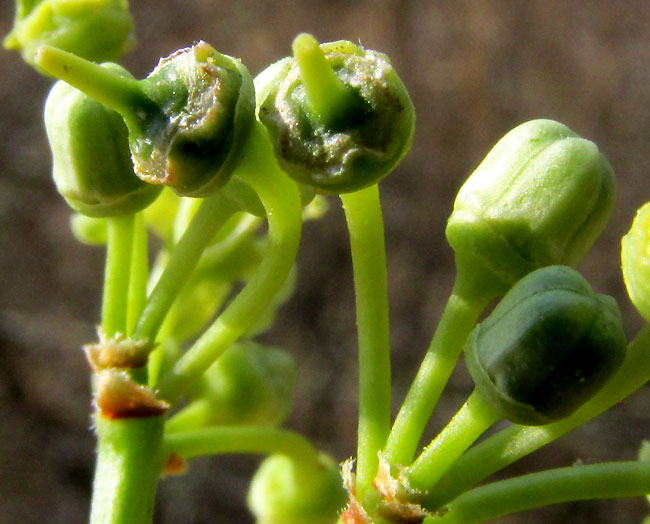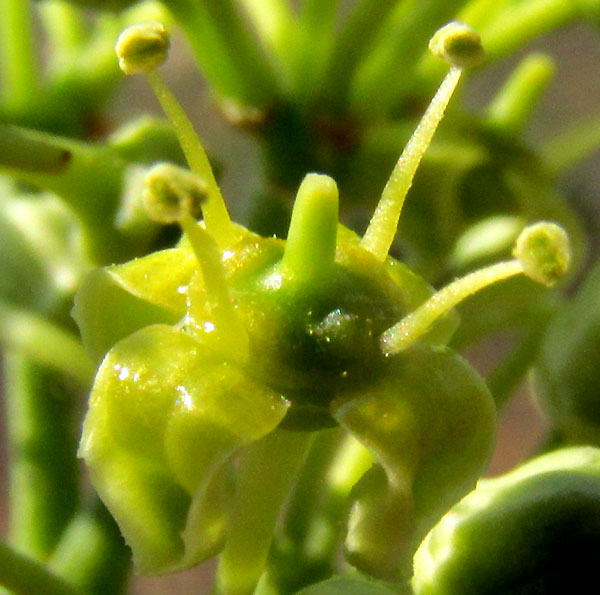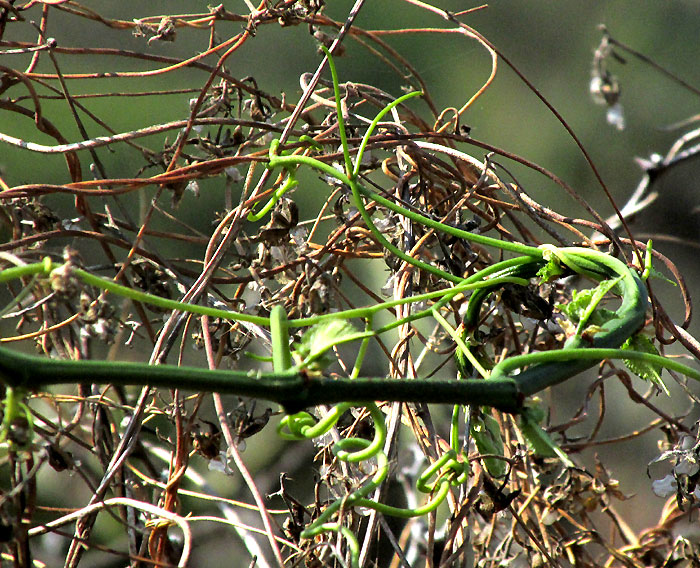Excerpts from Jim Conrad's
Naturalist Newsletter
entry dated May 21, 2022, notes from a camping trip among hills about 7kms ENE of Tequisquiapan, Querétaro state, MÉXICO
elevation about 2000m (6600 ft), near N20.57°, W99.85°
CISSUS FLOWERING

At the hot, dusty, glaringly sunny end of the dry season, the landscape here is mostly brown and gray. However, in anticipation of the rainy season, a few woody plants already are issuing new growth such as seen on the woody vine, or liana, twining along a roadside fence beside the road just north of La Higuera.
A closer look at an individual flower cluster immediately narrows our search for the plant family this liana belongs to:

The flower cluster's main stem, or peduncle, branches in one place into several secondary stems, at the tips of which arise several flowers on their own stems, or pedicels. This distinctive flower cluster, or inflorescence, is a "corymb-like cyme," a cyme being a flat-topped inflorescence in which the central flowers open first, those on the periphery coming later. A corymb is an inflorescence in which lower flower pedicels are proportionally longer than the pedicels on upper flowers, so that the whole inflorescence is flat or nearly so.
Our liana's inflorescence is only vaguely flat, so it is defined as corymb-like, but not a real corymb. Only a handful of families can produce corymb-like cymes. Since this is a twining liana with tendrils, we think of the Grape Family, the Vitaceae, which produces this kind of inflorescence...

In the above pictures, flowers on the right appear to wear green caps, while flowers on the left appear to have long, green noses. The caps are flower petals with their margins temporarily held together. It happens that a special feature of this species is that its caps are somewhat four-angled. Flowers on the left have lost their petals. The calyxes remain, though they don't look like most calyxes. They're the low, crown-like items surrounding the flowers' interiors. Here's a close look at a flower still bearing its petals:

The four yellow-green, flat, down-curving items are petals. Four stamens with their pollen-producing anthers arise opposite the petals. The "nose" in the center is a stigma-tipped style arising from the center of the mostly hidden ovary. If you look closely at the low area encircled by the stamen bases, or filaments, you'll see that the outer part, next to the filament bases, is somewhat irregular and not shiny like the ovary at the style's base. The irregular tissue is composed of nectar-producing nectaries.
Below, you can see that tendrils arising from the woody stems divide at their tips, and that those tips do not bear adhesive discs, which some members of the Grape Family do.

Leaves on this plant were just beginning to emerge, but still, below, you can see that they are simple leaves with broad, faintly heart-shaped blades.

All the above details lead us to CISSUS TILIACEA, which appears to have no English name. It's endemic just to semiarid upland parts of central Mexico, in the states of Guanajuato, Hidalgo, Jalisco, Michoacán, and here in Querétaro. Where it does occur in this limited area, it's described as relatively common in dry scrub, grasslands and adjacent oak forests, especially in rocky places.
If you look for more pictures of Cissus tiliacea on the Internet, you may see potted individuals looking somewhat like bonzai, and with deeply cut leaves completely unlike those on our wild plants. Often they are labeled as Cissus tuberosa. Apparently those are some kind of mutation much marketed in the gardening and house-plant world. The name Cissus tuberosa is a synonym of our Cissus tiliacea, the latter being the "real" name. And the name Cissus tiliacea is a venerable one, having been published by the German Kunth in 1822, based on plants sent by Humboldt and Bonpland collected when they were in our area in 1804.
Omar Franco-Mora's 2016 paper "Searching alternative uses for Cissus tiliacea Kunth fruit in Central Mexico: seed oil and fruit liquor" concludes that our Cissus tiliacea seeds are a potential source of bio-oil, and that the liquor brewed from the grape-like fruits is "acceptable."